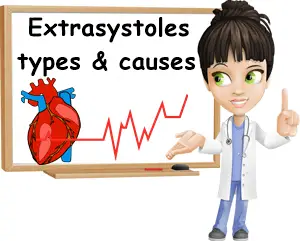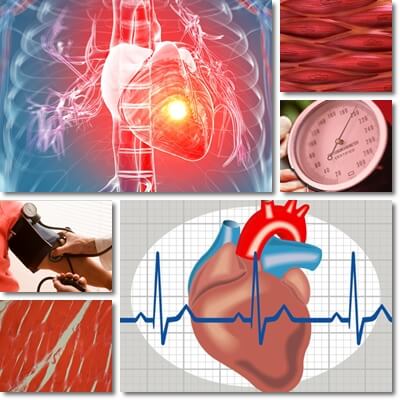Extrasystoles are one of the many types of heart arrhythmia which is also why they are colloquially called ‘extrasystoles of the heart’. There are actually different types of extrasystoles according to where in the heart they occur. Read on to find out what are extrasystoles of the heart, what are the different types of extrasystole and what to do when you have extrasystoles.
What does extrasystole mean?
An extrasystole literally means an ‘extra’ ‘systole’, that is, an additional rhythmic contraction of the heart, hence the colloquial denomination ‘extrasystole of the heart’. Or, in simpler words, one extra heart contraction or heart beat. But what is perceived as an extra systole is, in fact, a premature contraction of the heart that throws off normal heart rhythm. Because an extrasystole occurs prematurely, it feels or seems as if it’s extra when it actually just occurs unexpectedly early.

What are extrasystoles?
Heartbeats or heart contractions occur at a regular rate, which is known as heart rhythm. When the heart rhythm is off, more or fewer heartbeats or heart contractions than normal occur. This is called arrhythmia. Extrasystoles are one of the different types of arrhythmia. More exactly, extrasystoles are premature heartbeats or premature contractions of the heart. Extrasystoles are also classified into several different types according to where in the heart they occur, meaning, which chamber of the heart they affect.
What does it mean if you have extrasystoles?
Extrasystoles can occur in both healthy people, with no cardiovascular problems, and in people with heart disease. Most of the time however, extrasystoles are benign, or harmless, meaning they do not indicate or cause any heart or vascular problems. Many people who have extrasystoles are not even aware they have them. Changes in normal heart rhythm, formally known as arrhythmia, can be perceivable, or not. When they are indeed perceived, arrhythmias such as extrasystoles cause extreme psychological and emotional distress.

Extrasystoles types:
Extrasystoles are classified according to where in the heart they occur. The human heart has four chambers: the atrium is the upper part of the heart and it’s divided into two atria, the left atrium and the right atrium; the ventricle is the lower part of the heart and it’s divided into two ventricles, the left ventricle and the right ventricle. The atria receive blood from circulation and move it into the ventricles which then discharge the blood towards the body. Each chamber of the heart contracts and relaxes rhythmically to pump blood and move it along in the circulatory system. Extrasystoles or premature contractions can occur in any of the chambers of the heart.
Atrial extrasystoles
Atrial extrasystoles are premature contractions of the atria, or the upper chambers of the heart. They are also called PACs (premature atrial contractions), APCs (atrial premature complexes), APBs (atrial premature beats), or less commonly ‘extrasystoles auriculaires’. They can be symptomatic or asymptomatic, and are caused by fibers or group of fibers outside the area in the heart muscle normally responsible for the formation of the heartbeat impulse.
Ventricular extrasystoles
Ventricular extrasystoles are premature contractions of the ventricles, or the lower chambers of the heart. They are called PVCs (premature ventricular contractions) or, less commonly, ‘extrasystoles ventriculaires’. Ventricular extrasystoles are just as common as atrial extrasystoles, and can be symptomatic or asymptomatic. What causes ventricular extrasystoles is special heart muscle tissue called Purkinje fibers. Purkinje fibers are found in the walls of the ventricles of the heart and are made up of cells that are very sensitive to electrical stimuli, more sensitive than any other types of cells in the heart muscle.
Supraventricular extrasystoles
Supraventricular extrasystoles (SVES) are premature contractions of the heart muscle that occur ‘above’ the ventricles, meaning in one of two places:
- in the atria (the upper chambers of the heart).
- in the atrioventricular node which is a structure of the heart that connects the upper and the lower chambers of the heart, or the atria and the ventricles, electrically. The node normally conducts electrical impulses from the atria to the ventricles.
What do extrasystoles feel like?
If you’ve ever experienced any of the following sensations or symptoms, then you might have had an extrasystole:
- A skipped heart beat.
- A faster heart beat.
- A jolt in the heart.
- A flip in the chest.
- A heart hiccup.
- Nothing.
Extrasystoles can occur when you are in an emotionally altered state, when you’re under a lot of stress, when you’re engaged in intense physical activity, or when you’re calm and relaxed. It’s possible to experience extrasystoles after eating, before sleeping, when you wake up or at any time.
What to do when you have extrasystoles
If you ever experience an extrasystole, know that most of the time it’s nothing to worry about. Studies have diagnosed extrasystoles in perfectly healthy individuals with no signs of heart disease. But because not all extrasystoles are benign, it’s important to make an appointment with your doctor for some tests, just to be reassured you are healthy. Extrasystoles can be diagnosed via a simple electrocardiogram, also known as ECG or EKG test. The test takes 10-15 minutes tops and it’s painless, requiring you to only lie down for a few minutes with some electrodes attached to your chest, sometimes also wrists and ankles.
